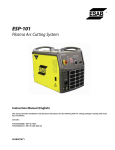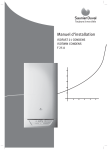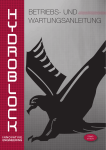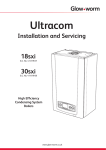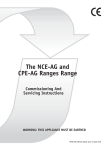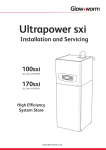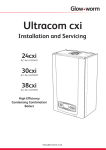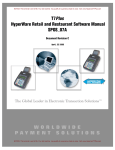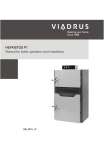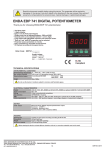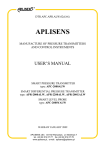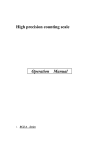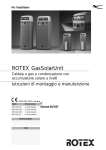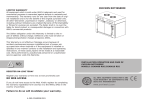Download SERVICE MANUAL
Transcript
24 kW Open Flued Gas Combination Boiler (bithermic type) 24 kW Room Sealed Fan Assisted Gas Combination Boiler (bithermic type) 24 kW Room Sealed Fan Assisted Gas Combination Boiler (monothermic type) 28 kW Room Sealed Fan Assisted Gas Combination Boiler (monothermic type) SERVICE MANUAL CONTENTS PRODUCT Product Notation Safety Systems Technical Data Main Components Operating Functions GAS TYPE CONVERSION Gas Pressure Adjustments Replacement Of The Burner Injectors Jumper Adjustment ADJUSTMENTS Service Setting Mode Chimney Sweep Push-Button PB4 FAULT & FAILURE 1 PRODUCT Product Notation Table 1 Notation Description FO 24 BB Fortius 24 kW Open Flued Gas Combination Boiler (bithermic type) FO 24 HB Fortius 24 kW Room Sealed Fan Assisted Gas Combination Boiler (bithermic type) FO 24 HM Fortius 24 kW Room Sealed Fan Assisted Gas Combination Boiler (monothermic type) FO 28 HM Fortius 28 kW Room Sealed Fan Assisted Gas Combination Boiler (monothermic type) Safety Systems The safety systems in appliance provide entire safety for user and appliance. The safety systems are: ¾ Flue Gas Safety System ¾ Flame Failure Safety System ¾ Over-heat Safety System (105 0C) ¾ DHW (Domestic Hot Water) Over-heat Safety System (75 0C) ¾ CH (Central Heating) Over-heat Safety System (95 0C) ¾ High Water Pressure Protection System (3 bar) ¾ Low Water Pressure Protection System (0,8 bar) ¾ Low Voltage Protection System (185 VAC) ¾ Thermal Accumalation Protection System (with by-pass circuit and “pump over-run”) ¾ Frost Protection System (The appliance must be on stand-by mode to activate frost protection system) ¾ Pump Anti-sieze Function ¾ 3 Way Anti-sieze Function (in monothermic types) ¾ Automatic Air Vent ¾ Expansion Vessel ¾ DHW safety stop function Technical Data Fortius 24 kW open flued gas combination boiler (FO 24 BB) is B type boiler (DIN EN 297). B type boilers have an open combustion chamber. Combustion air is provided from the installation room and products of combustion is discharged by means of approved flue ducts connections and a chimney. Therefore, they are named as room air dependent gas appliances. Fortius 24 / 28 kW room sealed fan assisted gas combination boilers (FO 24 HB, FO 24 HM, FO 28 HM) are C type boilers (DIN EN 483). C type boilers have a sealed combustion chamber. Required fresh air for combustion is provided independently from the installation room by concentric air/flue ducts and products of combustion can be also discharged by the same air/flue ducts. Therefore, they are named as air independent gas appliances. 2 Table 2 FO 24 BB FO 24 HB FO 24 HM FO 28 HM Gas Category* Boiler Type Type of gas II 2H 3+ B 11 BS Natural gas LPG II 2H 3+ C12x, C32 Natural gas LPG II 2H 3+ C12x, C32 Natural gas LPG II 2H 3+ C12x, C32 Natural gas LPG Performances Pmin, Min. Heat Output Pmaks, Max. Heat Output P%80, Heat Output Qmin, Min. Thermal Load Qmaks, Max. Thermal Load Q%80, Thermal Load 8,4 24 19,2 9,3 26,6 21,3 8,4 24 19,2 9,2 26,2 21 8,4 24 19,2 9,2 26,2 21 9,8 28 22,4 10,7 30,6 24,5 kW kW kW kW kW kW Gas Consumption** Natural Gas (Max. Load) Natural Gas (Min. Load) LPG 2,77 0,97 2,08 2,73 0,96 2,08 2,73 0,96 2,08 3,19 1,12 2,39 m3/h m3/h kg/h 20 28 / 37 20 28 / 37 20 28 / 37 20 28 / 37 mbar mbar Max. Flow Rate Min. Operating Pressure Max. Operating Pressure Set Temperature Range 3 10 (∆t=34) 0,3 10 35-60 3 10 (∆t=34) 0,3 10 35-60 3 10 (∆t=34) 0,3 10 35-60 3 12 (∆t=33) 0,3 10 35-60 ltr/min ltr/min bar bar o C Central Heating Min. Operating Pressure Max. Operating Pressure Set Temperature Range 0,8 3 40-80 0,8 3 40-80 0,8 3 40-80 0,8 3 40-80 bar bar o C 230V AC- 50Hz 230V AC- 50Hz 230V AC- 50Hz 230V AC- 50Hz 105 8 750x454x340 33,7 150 8 750x454x340 39,8 150 8 750x454x340 40,8 150 8 750x454x340 41,3 V AC/Hz Gas Supply Pressure Natural Gas LPG Unit Domestic Hot Water Min. Flow Rate For Activating*** General Electrical Supply Electrical Power Consumption Expansion Vessel Dimensions (HxWxL) Weight (Net) watt ltr mm kg **For gas consumption calculation ; Natural gas: Hu=9,59 kWh/m3 LPG: Hu=12,793 kWh/kg *** DHW ON flow rate can be adjustable as 3 ltr/min (default) or 3,5 ltr/min. *the following gas categories can also be used Gas Categories FO 24 BB FO 24 HB FO 24 HM FO 28 HM II 2H 3B/P II 2E 3B/P II 2H 3B/P II 2E 3B/P II 2H 3B/P II 2E 3B/P II 2H 3B/P II 2E 3B/P 3 Main Components Table 3a 1 2 3 4 5 6 FO 24 BB FO 24 HB Microcontroller Board Bitermic (Main Board) User Interface Gas Valve Burner (13 blade) 24 kW Heat Exchanger (bithermic) Microcontroller Board Bitermic (Main Board) User Interface Gas Valve Burner (13 blade) 24 kW Heat Exchanger (bithermic) Hydroblock (bithermic) Hydroblock (bithermic) 7 a) Pump a) Pump 8 9 b) 3 Bar Pressure Relief Valve c) Discharge Tap b) 3 Bar Pressure Relief Valve c) Discharge Tap 10 d) Filling Tap d) Filling Tap 11 e) Water Pres. Sensor e) Water Pres. Sensor 12 f) Water Flow Sensor f) Water Flow Sensor 13 - - 14 DHW NTC Sensor (Surface Mount) CH NTC Sensor (Direct Immersion) DHW NTC Sensor (Surface Mount) CH NTC Sensor (Direct Immersion) 16 - - 17 19 Limit Thermostat Expansion Vessel - 20 TTB Sensor 21 Manometer Ignition Electrode Ionization Electrode Timer Limit Thermostat Expansion Vessel Air Pressure Switch Fan Manometer Ignition Electrode Ionization Electrode Concentric Air/Flue Kit Timer 15 18 22 23 24 25 26 4 Table 3b 1 2 3 4 5 6 FO 24 HM FO 28 HM Microcontroller Board Monotermic (Main Board) User Interface Gas Valve Burner (13 blade) 24 kW Heat Exchanger (monothermic) Microcontroller Board Monotermic (Main Board) User Interface Gas Valve Burner (15 blade) 28 kW Heat Exchanger (monothermic) Hydroblock (monothermic) Hydroblock (monothermic) 7 a) Pump a) Pump 8 9 b) 3 Bar Pressure Relief Valve c) Discharge Tap b) 3 Bar Pressure Relief Valve c) Discharge Tap 10 d) Filling Tap d) Filling Tap 11 e) Water Pres. Sensor e) Water Pres. Sensor 12 f) Water Flow Sensor f) Water Flow Sensor 13 g) Plate Heat Exchanger (12 plate) h) DHW NTC Sensor (Direct Immersion) ı) CH NTC Sensor (Direct Immersion) j) 3 Way Electrical Valve g) Plate Heat Exchanger (14 plate) h) DHW NTC Sensor (Direct Immersion) ı) CH NTC Sensor (Direct Immersion) j) 3 Way Electrical Valve 14 15 16 17 18 19 20 21 22 23 24 25 26 Limit Thermostat Expansion Vessel Air Pressure Switch Fan Manometer Ignition Electrode Ionization Electrode Concentric Air/Flue Kit Timer Limit Thermostat Expansion Vessel Air Pressure Switch Fan Manometer Ignition Electrode Ionization Electrode Concentric Air/Flue Kit Timer 5 1 MICROCONTROLLER BOARD (MAIN BOARD) The main board operates on 230 VAC, 50 Hz and drives gas valve, fan, pump and (in monothermic types) 3 way electric valve. Dynamic air pressure test takes place before every ignition cycle. Limit thermostat ensures extra safety level. Flame in the burner is checked regularly. The main board provides all the functionality and safety of the boiler. The board was cased by a plastic casing, which was mounted on the gas valve. The functionality of the board is provided with 2 microcontrollers (low voltage and high voltage microcontroller). The board can be divided in 2 part: low voltage side and high voltage side. Both side have a microcontroller. There is continuous communication between microcontrollers. Numerous data is sent from one side to the another for check and comparison. 6 Wiring Diagrams fig. 1a 7 fig. 1b 8 fig. 1c 9 Tablo 4 Technical and Functional Specifications General Power supply range: 230 Vac -15% +10% Power supply frequency: 50 Hz ± % 2 Power consumption: 5 VA Max. admitted humidity: 90% @ 40 °C (non condensing) Working temperature range: -20 °C … 60 °C Electrical rating Fusing: 2A Fan output: 230 Vac 0.8 A maks, cosϕ ≤0.6 Pump output: 230 Vac 0.8 A maks, cosϕ ≤0.6 3-Way valve output (1): 230 Vac 0.8 A maks, cosϕ ≤0.6 3-Way valve output (2): 230 Vac 0.8 A maks, cosϕ ≤0.6 Total output: 2A Gas valve output: 230 Vrac, 50mA Diferantial air pressure switch input: 12 Vdc, 100 kOhm Limit thermostat input: 5 Vdc, 100 kOhm Water pressure switch input: 12 Vdc, 100 kOhm Water flow sensor input & output: Sensors input: - CH sensor - DHW sensor - TTB sensor 12 ± 4 Vdc, 10 mA max. Communication input: Communication output: 10 kOhm NTC “0” p 0,8 Vdc “1” + 2 … 24 Vdc (10 Ohm) 24 V and 10 mA max. User interface connectors High voltage spark: 2,8 x 0,5 mm spade terminal (2 pieces) Flame sensing: 4,8 x 0,5 mm spade terminal Mains connector: 10 pole Molex Minifit (male) Low voltage connectors: 16 and 6 pole Molex Microfit (male) Flame sensing Response time ON: < 0,2 sec Response time OFF: < 1 sec 10 Tablo 4 Technical and Functional Specifications Timing Pre purge time: 0 sec Waiting time: 0 sec Pre ignition time: 2 sec Safety time: 7 sec Number of retrials: 5 Flame failure response time: 1 sec Post ignition time: 0,4 sec Post purge time: 0,8 sec Pump over-run time: A) for DHW - Monothermic&Winter mode - Monothermic&Summer mode&3 way electric valve - Bithermic& Winter mode - Bithermic& Summer mode B) for CH - Winter mode - Summer mode 3 sec 5 sec 3 sec TCH > 75 °C: 1 sec TCH < 75 °C: 0 sec 10 min 5 sec Pump anti-seize run time: A) Bithermic type 5 sec B) Monothermic type 5 sec CH anti-cycling time: 3 min (0 min … 15 min) TTB error waiting time: 15 min Chimney sweep run time: 20 min Timing tolerance: ± 5% 11 Tablo 4 Technical and Functional Specifications Other Specifications Nr. of electrodes: 2 for flame ignition and one for detection Flame sensing cable and spark cable: max. 0,5 m External components (except heat demand): max 0,5 m Remote reset: max. of 5 reset in 15 minutes CH water SET temperature range: 40 °C … 80 °C CH water OFF temperature: CH water SET temperature + 10 °C CH water ON temperature: CH water SET temperature DHW water SET temperature range : 35 °C … 60 °C DHW water OFF safety temperature: 75 °C DHW ON Flow rate : 3,0 lt/min DHW OFF Flow rate : 2,5 lt/min Frost protection level 1 ON temperature: 8 °C (pump runs) Frost protection level 1 OFF temperature: 10 °C (pump is OFF) Frost protection level 2 ON temperature: 6 °C (burner runs) Frost protection level 2 OFF temperature: 30 °C (burner is OFF) Limit thermostat OPEN temperature: 105 °C Limit thermostat CLOSE temperature: 75 °C TTB sensor limit temperature (in the first 90 sec) 100 °C TTB sensor limit temperature (after the 90 sec) 70 … 95 °C 2 GAS VALVE Gas valve controls and modulates the gas flow to the burner. It consists of two valves: The first one is the on/off safety valve and the second one is the main (modulation) valve which enables safety and modulated gas control. Maximum and minimum operating pressures can be adjusted mechanically on the gas valve. Maximum outlet pressure can be adjusted with the adjustment screw of the maximum pressure regulator. Minimum outlet pressure can be adjusted with the mechanical minimum adjustment screw (see Gas pressure adjustment, page 30). Table 5 Gas Valve Natural Gas Max. pressure setting (factory default) (mbar) Min. pressure setting (factory default) Max. pressure setting (factory default) LPG (mbar) Min. pressure setting (factory default) Gas inlet & outlet connections 24 kW Models 11,2 1,3 28 / 35 3,3 / 4,1 G ¾” 28 kW Models 11,3 1,2 28 / 35 3,4 / 4,2 G ¾” (External thread) (External thread) 12 fig. 2 Gas Valve 3 BURNER The gas coming from the gas valve is fired in the burner. 13 blade burners are used in 24 kW boilers while 15 blade burners are used in 28 kW boilers. Some of the common specifications of these two burners are shown in the table below. Table 6 Burner ∅ 1,25 mm ∅ 0,75 mm G ¾” (External thread) Injector (nozzle) diameter for natural gas Injector (nozzle) diameter for LPG Gas inlet connection fig. 3 Burner 13 4 HEAT EXCHANGER Heat exchanger is the component which enables transferring the energy produced by the burning of the gas to the water circuit. Different heat exchangers are used in bithermic (24 kW) and monothermic (24 / 28 kW) models. In bithermic heat exchangers which have two water inlets and two water outlets, both central heating and domestic hot water circuits are heated. In monothermic types, the exchanger has only one water inlet and one water outlet and only the central heating circuit is heated. In monothermic types, domestic hot water circuit is heated by a second exchanger (plate-heat exchanger). In both heat exchangers, there is a manual air vent on central heating inlet. Table 7 Heat Exchanger Bithermic heat exchanger (24 kW) Central heating inlet & outlet connections Domestic hot water inlet & outlet connections Monothermic heat exchanger (24 kW) Water inlet & outlet connections Monothermic heat exchanger (28 kW) Water inlet & outlet connections G ¾” (External thread) G ½” (External thread) G ¾” (External thread) G ¾” (External thread) fig. 4a Bithermic Heat Exchanger 14 fig. 4b Monothermic Heat Exchanger 5 HYDROBLOCK Two different types of hydroblocks are used in bithermic and monothermic types. Hydroblock consists of different components depending on the boiler model. The bithermic hydroblock has pump, pressure relief valve (3 bar), discharge tap, filling tap, water pressure switch and water flow sensor on it. The monothermic hydroblock has pump, pressure relief valve (3 bar), discharge tap, filling tap, water pressure switch, plate heat-exchanger, water flow sensor, domestic hot water (DHW) sensor, central heating (CH) sensor and 3 way electric valve on it. On both hydroblocks, inlet and outlet manifolds are connected by a by-pass pipe. 15 fig. 5a Bithermic Hydroblock 1 Outlet manifold 2 Inlet manifold 3 By-pass pipe 4 Water flow sensor 5 Filling tap 6 Gasket (G3/4” & G1/2”) 7 Hall effect sensor 16 fig. 5b Monothermic Hydroblock 1 3 way electric valve 2 Inlet manifold 3 By-pass pipe 4 Water flow sensor 5 Filling tap 6 Valve motor 7 Valve motor clip 8 Hall effect sensor 9 Bolt 10 Oring 11 By-pass pipe clip 17 6 PUMP Pump enables the central heating water circulation in monothermic and bithermic types. Also in monothermic types, it enables heating the domestic water passing through the plate heat-exchanger by causing the central heating water short circuit circulation. Pump is located on the hydroblock and has 3 speed stages. The pump has expansion vessel and termomanometer connections and also an automatic air vent on it. fig. 6 Pump Table 8 Pump Maximum Power Speed Stages Hydroblock connection (pump water inlet) Pump water outlet connection Termomanometer connection Expansion vessel connection 85 W 3 Rapid connection (O-ring) G ¾” (External thread) Rapid connection (O-ring) Rapid connection (O-ring) fig. 7 Pump’s Characteristic Curve (Height & Flow) 18 7 PRESSURE RELIEF VALVE (3 BAR) Pressure relief valve (3 bar) protects the central heating circuit and the appliance against increasing pressure. When the pressure in the central heating circuit is over 3 bars, the relief valve functions and decreases the pressure (the outlet tap of the 3 bar relief valve should be connected to the drain line with a plastic hose). The pressure relief valve is on the hydroblock, on the central heating return. Table 9 Pressure relief valve Hydroblock connection Water discharge pipe connection Rapid connection (O-ring) G ½” fig. 8 Pressure Relief Valve 8 DISCHARGE TAP The discharge tap is used for removing the water in the central heating circuit. It is on the outlet manifold in bithermic types while it is on the inlet manifold in monothermic types. Table 10 Discharge Tap Hydroblock connection G ¼” (External thread) 9 FILLING TAP The filling tap is for filling the central heating circuit using the domestic water line. It is integrated on the inlet manifold of the hydroblock. 10 WATER PRESSURE SWITCH Water pressure switch prevents the operation of the appliance in low water pressure. If the water pressure in the central heating circuit is below 0.8 bar, the water pressure switch goes OFF and the signal sent from the water pressure switch to the main board prevents the boiler operation. When the pressure is above 1 bar, the boiler goes back to normal operation. The water pressure switch is on the outlet manifold of the hydroblock, on the central heating flow. The electric circuit connection of the water pressure switch is COM and CO terminals (NC not connected). TABLE 11 Water Pressure Switch Hydroblock connection G ¼” (External thread) 19 fig. 9 Water Pressure Switch 11 PLATE HEAT-EXCHANGER Plate heat-exchanger is the secondary heat-exchanger used in monothermic types for heating the domestic water. In need of domestic hot water, the 3 way electric valve sends the central heating water from the primary heat-exchanger to the plate heat-exchanger. Heat of the central heating water is transferred to the domestic water in the plate heat-exchanger. 12 plate type are used in 24 kW boilers while 14 plate type are used in 28 kW boilers. The plate heat-exchanger is mounted using two bolts on the monothermic hydroblock. Leakage in the inlet and outlet of central heating and domestic hot water circuits is prevented using O-rings. Table 12 Plate Heat-Exchanger Hydroblock connection Plate heat-exchanger water inlet & outlet onnections Bolts (2 pieces) O-rings (4 pieces) fig. 10 Plate Heat-Exchanger 12 WATER FLOW SENSOR The water flow sensor measures the domestic hot water flow rate. It is integrated in the inlet manifold of the hydroblock in both bithermic and monothermic types. A turbine in the water flow sensor rotates during flow and supports a magnet. The turbine creates a magnetic field. The hall effect sensor reacts to the magnetic field and sends data to the main board. The main board controls the domestic hot water delivery according to the flow rate values delivered from the water flow sensor. When the water flow rate reaches 3 lt/min, domestic hot water delivery begins. When the rate is below 2.5 lt/min, domestic hot water delivery is stopped. The hall effect sensor is on the water flow sensor and can be easily mounted or removed. 20 fig. 11 Water Flow Sensor 13 CENTRAL HEATING AND DOMESTIC HOT WATER (NTC) TEMPERATURE SENSORS The central heating and domestic hot water temperature sensors are NTC (Negative Temperature Coefficient) type. In NTC sensor, temperature and sensor resistance are inversely proportional; the sensor resistance decrease as temperature increases and vice versa. NTC sensors are usually defined by their nominal resistance at 25°C, but this value does not completely define the nominal R-T curve of the NTC. The R-T relation of the NTC sensors used in our appliances are shown in Table 14. Temperature sensors measures the temperature of the central heating and domestic hot water and send signals to the main board. Two types of temperature sensors are used in bithermic types, surface mounted sensors for domestic water and direct immersion sensors for central heating. Only direct immersion NTC sensors are used in monothermic types. In bithermic models, the surface mounted temperature sensor is directly mounted on the domestic water delivery (outlet) pipe and the direct immersion temperature sensor is mounted on the central heating flow of the heat-exchanger. In monothermic types, the direct immersion temperature sensors (CH & DHW) are mounted on the outlet manifold of the hydroblock (3 way electric valve). Central heating circuit over-heat safety (electronic limit - 95°C) is secured by the central heating NTC sensor and domestic water over-heat safety (electronic limit - 75°C) is secured by the domestic water NTC sensor. Table 13 NTC Temperature Sensors Surface mounted temperature sensor connection Direct immersion temperature sensor connection a) surface mount With Klips 1/8” (external thread) b) Direct immersion fig. 12 NTC Temperature Sensors 21 Table 14 The R-T relation of the NTC sensors T (oC) Temperature -20 -10 0 10 20 25 30 40 50 60 70 80 85 90 100 110 120 125 R (Ω) Resistance 98660 56250 33210 20240 12710 10170 8194 5416 3663 2530 1782 1278 1089 931,6 690,0 518,5 395,0 346,4 α (1/oC) Sensitivity -5,8 % -5,4 % -5,1 % -4,8 % -4,5 % -4,4 % -4,3 % -4,0 % -3,8 % -3,6 % -3,4 % -3,2 % -3,2 % -3,1 % -2,9 % -2,8 % -2,7 % -2,6 % The sensitivity α is the percentage change in resistance of the sensing element per oC temperature change at the specified temperature. 14 3 WAY ELECTRİC VALVE 3 Way electric valve sends the central heating water coming from the main heat-exchanger to the plate heat-exchanger when domestic hot water is needed in monothermic models. When there is no more need for domestic hot water, valve gets back to its previous position enabling central heating. fig. 13 3 Way Electric Valve 22 15 LIMIT THERMOSTAT The limit thermostat used is bimetal type. When water CH from the heat-exchanger exceeds 105°C, the limit thermostat opens and cuts the signal sent to the main board and ensures safety. When the water temperature is below 75 °C, the limit thermostat closes enabling the boiler to operate again after the reset. In bithermic types, limit thermostat is mounted on the heat-exchanger with a metal clip while in monothermic types it is mounted using two screws. fig. 14 Limit Thermostat 16 EXPANSION VESSEL Expansion vessel covers the expansion of water in the central heating circuit which is a closed circuit. Table 15 Expansion Vessel Expansion Vesssel Volume Water Inlet Connection 8 liters G ½” (external thread) fig. 15 Expansion Vessel 23 17 DIFFERENTIAL AIR PRESSSURE SWITCH (APS) Differential air pressure switch is used in room sealed fan assisted models. It controls the air flow by measuring the pressure differences of the clean air required for burning and flue gas. In case of problems like blockage in the air/flue kit or a strong outer air flow, the air pressure switch shuts down the boiler. The low pressure inlet of the differential air pressure switch is connected to the fan with a silicon hose. The high pressure inlet is connected to the combustion body again with a silicon hose. When the boiler is started, the differential air pressure switch is already open. The fan operates, and after a certain period of time, when the pressure difference is above the predefined value the switch closes and the boiler begins operating. When the pressure difference is under certain value, the switch opens and prevents the operating of boiler. The electric circuit of the differential air pressure switch is connected to terminals (1) and (3) (2 not connected). Table 16 Differential Air Pressure Switch Interior diameter of silicon hose to fan Interior diameter of silicon hose to combustion body 5 mm 5 mm Low pressure inlet (P2) High pressure inlet (P1) fig. 16 Differential Air Pressure Switch 18 TTB TEMPERATURE SENSOR The TTB temperature sensor is an NTC sensor like the central heating and domestic water temperature sensors. The R-T relation of the sensor is shown in Table 17. TTB temperature sensor measures the temperature of the flue gas in open flued boilers. If the flue gas temperature exceeds the limit value because of blockage in the flue system or insufficient chimney draught, the TTB sensor shuts down the boiler by sending a signal to the main board and the boiler can not be started for 15 minutes. The TTB temperature sensor is mounted to hood using two screws. The TTB temperature sensor limit value differs according to operating capacity. a) In the first 90 sec., TTB sensor limit temperature is 100°C. b) After the 90 sec. of start up period, the limit temperature is between 75 - 95 °C depending on the boiler capacity. 24 fig. 17 TTB Temperature Sensor Table 17 The R-T relation of the TTB sensor T (oC) Temperature -20 -15 -10 -5 0 5 10 15 20 25 30 35 40 45 50 55 60 65 70 75 80 85 90 95 100 105 110 115 120 125 130 R (Ω) Resistance 97060 72940 55319 42324 32654 25396 19903 15714 12493 10000 8056 6530 5327 4370 3603 2986 2488 2083 1752 1480 1255 1070 915 787 680 592 517 450 390 340 300 α (1/oC) Sensitivity -5,8 % -5,6 % -5,4 % -5,3 % -5,2 % -5,1 % -4,8 % -4,7 % -4,5 % -4,4 % -4,3 % -4,2 % -4,0 % -3,9 % -3,8 % -3,6 % -3,6 % -3,5 % -3,4 % -3,3 % -3,3 % -3,3 % -3,2 % -3,1 % -3,0 % -2,9 % -2,8 % -2,7 % -2,6 % -2,6 % -2,5 % The sensitivity α is the percentage change in resistance of the sensing element per oC temperature change at the specified temperature. 25 19 FAN Fan enables taking the clean air required for combustion to the combustion chamber and disposing of flue gas in room sealed fan assisted boilers. Table 18 Fan Maximum Power Interior diameter of silicon hose connected to APS 55W 5 mm fig. 18 Fan 20 TERMOMANOMETER Termomanometer displays the water temperature and water pressure of the central heating circuit. 21 IGNITION ELECTRODE The burner is ignited by a spark between two ignition electrodes. One of the electrodes is earthed. A 1k resistor is attached on the cable of one of the electrodes against the oscillations caused by EMC. 22 IONIZATION ELECTRODE Ionization electrode checks whether there is fire in the burner or not by creating a current and sending data to the main board during burning process. 26 MODES OF OPERATION a) Stand-by Mode: when there is no heat demand for central heating or domestic hot water. b) Domestic Hot Water (DHW) Mode: when there is need for DHW (hot water tap is opened), the hall effect sensor on the water flow sensor detects the water flow and signals the main board for DHW delivery. c) Central Heating (CH) Mode: can be activated in two ways: - Rotate the CH potentiometer (P1 potentiometer) to the winter mode. - Internal frost protection requests heat. d) Frost Protection: It automatically functions according to the water temperature values detected by CH and DHW temperature sensors in order to protect the water circuits against freezing. The ON/OFF switch should be in ON position for frost protection system to activate. e) Service Settings Mode: This mode can be activated by pushing the PB3 service button on the control panel and is used for boiler settings. f) Fault/Error Conditions: like sensor faults or over temperature. The priority of the modes of functions is as follows: 1. Fault/Error Condition 2. Service Settings Mode 3. DHW Mode 4. CH Mode 5. Frost Protection 6. Stand-By Mode If there is no error or fault, service settings have the highest priority. For example in case of an over heating condition, the system should reach normal temperature conditions before service settings mode can be activated. 1 Stand-by Mode In stand-by mode, the pump does not function (if the pump over-run time is finished), the burner and the gas valve are OFF. 2 Domestic Hot Water If there is no error condition and the water flow detected by the hall effect sensor is enough, the boiler will supply domestic hot water. DHW mode starts when the flow rate reaches 3 lt/min. and ends when flow rate is less then 2.5 lt/min. The flow sensor has a flow limiter in it. Flow rate is limited to 10 lt/min. in 24 kW models and 12 lt/min. in 28 kW models. ¨ DHW Mode Control Variables: - DHW potentiometer (P2 potentiometer) - Water temperature detected by DHW temperature sensor - Water flow rate 27 - Domestic hot water can be obtained between 35°C and 60°C. - Domestic hot water safety temperature is 75°C. If the temperature detected by DHW sensor is above 75°C, DHW operation will stop (burner goes off). - DHW operation is possible even if CH anti-cycling time is active. - During DHW operation, min.-max. running mode selection is not possible with PB4 button (see page 39) in both bithermic and monothermic types. ¨ DHW priority cancellation function DHW mode has priority over CH mode, but monothermic type boilers have DHW priority cancellation zone. The cancellation zone is between 30 oC and 35 oC on the DHW potentiometer. In DHW priority cancellation zone, it is not possible to have domestic hot water even if hot water tap is open. And the 3 way electric valve remains open to CH circuit. ¨ DHW safety stop function if DHW mode is active for a period longer than 60 min., DHW mode will stop automatically except for winter operation in bithermic types, and the boiler will operate depending on system configuration: a) In Monothermic types - if the boiler is in summer mode, the burner will switch OFF, and to reactivate DHW mode again, it is necessary to close the hot water tap and open it again. - if the boiler is in winter mode, winter mode will be active until closing the hot water tap and open it again. b) In Bithermic types - if the boiler is in summer mode, the burner will switch OFF, and to reactivate DHW mode again, it is necessary to close the hot water tap and open it again. - if the boiler is in winter mode, DHW safety stop function wiil not be active. ¨ DHW mode frost protection In stand-by mode, if the DWH temperature sensor detects temperature less then 6°C, CH mode is activated (burner starts). As long as frost protection conditions last (till water temperature reaches 30°C) the burner operates in minimum capacity. When the water temperature reaches 30°C, burner goes off. 3 Central Heating Mode The pump operates as long as the CH mode is active. When CH mode ends (and there is no DHW demand), pump stops after pump over-run time. This condition is valid when the boiler is in pump control mode 1 or pump control mode 2 and the room thermostat is connected. If the boiler is in pump control mode 2 and the room thermostat is not connected, the pump will start operating when the boiler is switched ON and will operate until switched OFF or a CH circuit low water pressure error occurs or until there is DHW demand in bithermic models. If DHW mode is activated in the pump over-run time following the CH mode, pump over-run time is not completed. This prevents the hot water from going to CH circuit. ¨ CH Mode Control Variables: - CH potentiometer (P1 potentiometer) - Water temperature detected by CH temperature sensor - Hystherisis (10 °C) 28 - When there is CH demand, ignition starts and ignition state continues until flame is present. - When the ignition state is over, the boiler will operate in normal modulation and reach the set point within the time defined with slope (°C/min). After that, modulation continues. - If the central heating water temperature exceeds 95°C in CH mode, over temperature error (electronic limit) occurs and the boiler will remain in this error mode till water temperature drops to a safe level (80°C). Pump keeps working in the over temperature error condition. When the temperature drops, the boiler continues normal operation. This is a safety measure and should not normally occur because when the water temperature exceeds the value set by the user plus hystherisis ( max.80°C +10°C), the burner will go off. - Water temperature interval in CH mode is 40°C - 80°C. ¨ Outside temperature control (OTC) option The boiler (CH mode) can operate depending on outside temperature if a OTC sensor is connected to heating system. The pump has no over-run time. - OTC has priority over room thermostat (if present). - OTC function is only active when the boiler is in winter mode. ¨ CH mode frost protection In stand-by mode, if the CH temperature sensor detects temperature less then 6°C, CH mode is activated (burner starts). As long as frost protection conditions last (till water temperature reaches 30°C) the burner operates in minimum capacity. When the water temperature reaches 30°C, burner goes off. 4 Pump Behaviour The pump functions differently depending on the boiler operating modes. ¨ In Stand-by Mode: The pump does not normally work in stand-by mode. The pump will function in the following conditions: - In pump over run time - If the temperature detected by the CH sensor is over 85°C, the pump will keep running till water temperature drops to 80°C. - Frost protection level 1: If the temperature detected by the CH sensor is below 8°C, the pump will start running and keep running till the temperature reaches 10°C. - In case of an error condition pump will switch on except low water pressure error which will prevent the pump from dry running. Exceptional Situation: The pump will run permanently in stand-by mode if the boiler is in pump control mode 2 and the room thermostat is not connected. ¨ In DHW Mode: In monothermic types, when DHW mode begins, pump will run as in the CH mode (In bithermic types, pump does not run in DHW mode). After DHW mode ends, pump behaviour depends on system configuration: - Monothermic & Winter Mode: pump runs for the defined over run time (3sec). - Monothermic & Summer Mode & 3 Way Electric Valve: pump will run for 5 sec. more. 29 - Bithermic & Winter Mode: pump runs for the defined over run time (3sec). This is for transferring the remaining energy to the CH circuit. - Bithermic & Summer Mode: if the temperature detected by the CH temperature sensor is more then 75°C, the pump will run for 1 sec., otherwise it will not run. ¨ In CH Mode: - Pump always runs when CH mode is active. After the CH mode is ended, the pump will run for the defined period of time (10 min.) - If the boiler is switched to summer mode when CH mode is active, pump over run time is 5 sec. 5 Pump Anti-Seize Function The pump may be blocked if not used for a long period of time. To prevent this, 24 hours after the pump has run for the last time, it is run for 5 sec. in CH mode. 6 3 Way Anti-Seize Function In monothermic models, 3 way valve blocking protection becomes active with pump blocking protection and changes position to prevent blocking. 7 Fault/Error Conditions Fan does not run in lock out and blocking conditions. Pump will not run only in low water pressure condition. 30 GAS TYPE CONVERSION : Gas type conversion from LPG to natural gas or from natural gas toLPG must be carried out only by qualified person. - Gas type conversion can be divided in 3 sections: gas pressure adjustments, replacement of the burner injectors and jumper adjusment. Gas Pressure Adjustments The operating pressure varies depending on the type of gas. Therefore, minumum and maximum operating gas pressure must be set by means of the adjusment screws that are on top of the gas valve. The heat output directly depends on the operating pressure. When the operating gas pressure range is adjusted, minimum and maximum heat output is also adjusted (mechanically). 24 kW Models 28 kW Models Max. operating gas pressure (mbar) 11,2 11,3 Min. operating gas pressure (mbar) 1,3 1,2 Max. operating gas pressure (mbar) 28 / 35 28 / 35 Min. operating gas pressure (mbar) 3,3 / 4,1 3,4 / 4,2 Table 19 Natural Gas LPG - Firstly, operate the boiler at maximum load while adjusting maximum operating pressure and operate the boiler at minimum load while adjusting minumum operating pressure. - Undo the 2 screws which are located on the lower edge to remove the front panel. - Undo the 2 screws which are located on the corners of the control panel. - Pull the control panel outwards to reach the gas valve. ¨ Maximum operating pressure adjustment: - Operate the boiler at maximum load. - Connect the tube of a clocking gas meter to outlet pressure tap whose diameter is φ=9 mm (fig. 19) after loosening the tap’s screw. - Remove cap screw from maximum pressure regulator to expose pressure regulator adjusment screw which is seen as (2) in fig. 19. - Turn the adjustment screw clockwise to increase or counter-clockwise to decrease gas flow to the burner. - Check gas pressure measurements on the gas meter to satisfy the desired value. In LPG operation, the adjustment screw (2) is tightened to the end for 28 / 35 supply pressure. ¨ Minimum operating pressure adjustment: - Operate the boiler at minimum load. - Connect the tube of a clocking gas meter to the outlet pressure tap. - Turn the adjustment screw which is seen as (1) in fig. 19 counter-clockwise to increase or clockwise to decrease gas flow to the burner. - Check gas pressure measurements on the gas meter to satisfy the desired value. - Ensure that the tap’s screw is tightened after making the adjustments. - Replace pressure regulator cap screw. - Reassemble the front panel and the control panel. 31 fig. 19 Replacement Of The Burner Injectors WARNING:Keep the gas valve on the boiler and electricity supply closed during replacement of the burner injectors. - Shut off the boiler by turning the ON/OFF switch to OFF position and turn off the gas valve on the boiler. - Undo the 2 screws which are located on the lower edge to remove the front panel. - Undo the 2 screws which are located on the corners of the control panel. - Pull the control panel outwards. - Undo the 6 screws which are located around the body to remove the combustion body cover (in room sealed fan assisted boiler). - Undo the 4 screws which fasten the manifold to the burner to remove the burner. - Fix the suitable burner injectors according to type of gas (13 pieces of injectors used in 24 kW models / 15 pieces of injectors used in 28 kW models). - Reassemble in the reverse order. Injectors Diameter Table 20 Natural Gas ∅ 1,25 mm LPG ∅ 0,75 mm Jumper Adjustment When the appliance is converted to LPG, jumper X7 must be short circuit. If the appliance is supplied with natural gas, jumper X7 must be open circuit. WARNING: Maximum pressure regulator must be sealed and the self-adhesive conversion label must be placed on the boiler after gas type conversion. 32 WARNING: In case of gas leak, fire or explosion hazard, property damage, severe injury or death can happen. Therefore, gas leak test must be performed by qualified person after gas type conversion. ¨ GAS LEAK TEST ¾ Apply a rich soap and water solution to the surface of all pipe connections. Bubbles indicate a gas leak ¾ In case of gas leak, tighten the pipe connection. ¾ Check the pipe connection again for gas leak. ¾ Replace the part/parts if gas leak can not be stopped. CAUTION: Keep soap and water solution away from electrical connections during gas leak test . 33 ADJUSTMENTS LED’s have 6 different signals. The definitions: • ON • OFF • Slow blink: 0.75 sec ON - 0.75 sec OFF • Fast blink: 0.10 sec ON - 0.40 sec OFF • Change blink: 0.75 sec ON - 0.25 sec OFF (it seen when adjusting service setting parameters) • Update blink: 0.15 sec ON - 0.15 sec OFF (it seen when adjusting service setting parameters) Service Level (read-out modes, setting mode and fault history) - In case of normal operation in DHW or CH mode and no error conditions it is always possible to enter the service level by pressing the service push-button PB3. If there was an error condition, service level can be entered after normal operating conditions are reached again. - Service level consists of 4 level (L1, L2, L3, L4). Level 1 (L1) and Level (L2) are read-out modes to read some boiler parameters Level 3 (L3) is setting mode to set some boiler parameters. Level 4 (L4) is fault history and permits to read the last 8 error codes. - While in service level. LED L7 is on (fig. 20) Service level is active. L1 L2 ON OFF L3 7 segment display L7 L8 L9 ON OFF OFF fig. 20 - All read-out and setting modes including fault history display is disappeared and deactivated after 2 minutes if nothing done. 1 Level 1 (read-out mode) - Press PB3 service push-button once, and see “ L 1 ” on the 7 segment display. - Press PB2 user push-button once. Anti-cycling time will appear on the 7 segment display. Table 21 7 segment display 1st 2nd after pressing after pressing PB2 once PB3 once L1 88 Description Anti-cycling time - After pressing PB2 one more time, the display goes back to “ L 1 ”. 2 Level 2 (read-out mode) - Press PB3 service push-button twice, and see “ L 2 ” on the 7 segment display. - Press PB2 user push-button progressively to read some parameters detailed in Table 22. 34 Table 22 7 segment display 1st 2nd after pressing after pressing PB2 PB3 twice progressively L2 88 88 88 88 88 P1 P2 88 88 88 Description 1st press: Flame current 2nd press: Modulation level 3rd press: DHW flow frequency 4th press: Flue temperature (for room sealed type, it's fixed as 25) 5th press: TTB calculated value 6th press: Pump control mode 7th press: Room temperature (if a open therm thermostat connected) th 8 press: Software version number for main board (CVBC) 9th press: Software version number for user interface (DSP) - After the 10th press PB2, the display goes back to “ L 2 ”. 3 Level 3 (setting mode) - Press PB3 service push-button 3 times, and see “ L 3 ” on the 7 segment display. - Press PB2 user push-button progressively to reach some parameters detailed in Table 23. - The parameters are set by means of the CH potentiometer (P1). The parameters can be increased by turning the CH potentiometer clockwise or decreased by turning the CH potentiometer counterclockwise. The 7 segment display shows the set value during adjustment. Table 23 7 segment display 1st 2nd after pressing after pressing PB2 PB3 progressively 3 times 88 88 88 88 F1 F2 L3 d1 d2 88 O1 O2 P1 P2 88 Description 1st press: CH minimum power set point 2nd press: CH maximum power set point 3rd press: Ignition power set point 4th press: Anti-cycling time set point 5th press: DHW ON-OFF flow rate set point 6th press: DHW delay time set point 7th press: OTC curve foot point 8th press: Outside temperature limiting set point 9th press: Pump control mode selection 10th press: Modulation start point ∆T (F/R), if return sensor existing 35 - After the 11th press PB2, the display goes back to “ L 2 ”. - If PB3 is pressed continuously more than 5 seconds, all LED blink three times and the parameters are set to the factory defaults (Minimum Power, Maximum Power, Ignition Power, Anti-Cycling Time, DHW ON-OFF flow rate, OTC curve foot point, Pump Control Mode and Modulation Start Point). See table 24. ¨ Minimum Power - The minimum power (heat output), was limited mechanically by means of the adjusment screw that are on the gas valve, can be increased %0 … % 30. ¨ Maximum Power - The maximum power (heat output), was limited mechanically by means of the adjusment screw that are on the gas valve, can be decreased %0 … %20. ¨ Ignition Power The ignition power can be incerased % 20 … % 70. ¨ Anti-Cycling Time Adjustment - Anti-cycling time restricts CH demands for a certain time to prevent the boiler from frequently goes ON (CH mode) or OFF (stand-by). The factory defaults of anti-cycling time is 3 minutes and also can be adjusted between 0 and 15 minutes. ¨ DHW ON-OFF Flow Rate - DHW ON-OFF flow rate (ltr/min) can be adjusted as F1: ON=3 OFF= 2,5 or F2: ON=3,5 OFF= 3. ¨ DHW Delay Time - In order to avoid water hammer effect in DHW mode, DHW delay time can be adjusted as d2: 1 (sec) or it can be adjusted as d1: 0 (sec) for inactive the function. ¨ OTC Curve Foot Point Foot point, defines the bottom point of the heating curves (please see page 40 FORTIUS Installation and User’s Operating Instructions), can be adjusted between 10 oC … 50 oC. ¨ Outside Temperature Limiting Set Point By means of this value, it can be defined from an outside temperature more than 18º C, the heating process (burner and the pump) will be automatically activated (o1) or inactivated (o2). ¨ Pump Control Mode a) Mode 1 should be selected when a room thermostat is not connected to the boiler. In this condition, when heat demand (CH or DHW) ends, pump stops after pump over-run time b) Mode 2 should be selected when a room thermostat is connected to the boiler. In this condition, CH temperature sensor controls only gas circuit. The room thermostat controls both gas circuit and the pump. Also, the pump has over-run time. If the boiler is in mode 2 and a room thermostat is not connected, the pump runs permanently. Pump control mode 2 is factory default. 36 Table 24 Parameters No 1 2 3 4 5 6 Definition o CH water SET temperature range ( C) DHW SET temperature range (oC) Minimum power (%) Maximum power (%) Ignition power (%) Anti-cycling time (min) 7 DHW ON-OFF flow rate (ltr/min) 8 DHW delay time (sec) F1: ON=3 OFF= 2,5 F2: ON=3,5 OFF= 3 d1: 0 d2: 1 9 OTC curve foot point (oC) o1: inactive o2: active P1: Mode 1 11 Pump control mode P2: Mode 2 12 Modulation start point ∆T (F/R), if return sensor existing (oC) 10 Outside temperature limiting set point Range 40 – 80 35 – 60 0 – 30 80 – 100 20 – 70 0 – 15 10 - 50 - Default 3 100 50 3 10 - 30 20 F1 d1 25 o1 P2 3 Level 4 (fault history) - Press PB3 service push-button 4 times, and see “ L 4 ” on the 7 segment display. - Press PB2 user push-button progressively to reach the last 8 error codes Table 25 7 segment display 1st 2nd after pressing after pressing PB2 PB3 progressively 4 times L4 88 88 88 88 88 88 88 88 Description 1st press: error code 2nd press: error code 3rd press: error code 4th press: error code 5th press: error code 6th press: error code 7th press: error code 8th press: error code - After the 9th press PB2, the display goes back to “ L 4 ”. 37 Chimney Sweep Push-Button PB4 Chimney sweep push-button PB4 has two functions: a) to activate the chimney sweep mode, b) to activate the minimum and maximum running mode without modulation. a Chimney Sweep Mode - If the push-button PB4 is pressed more than 3 seconds and less than 5 seconds, chimney sweep mode is activated (fig. 21a). Chimney sweep mode is active. L1 L2 ON OFF L3 7 segment display L7 L8 L9 88 OFF OFF fast blink fig. 21a - Appliance operates in maximum load without modulation. - The chimney sweep mode remains activated for 20 minutes (fig. 21b) or it can be deactivated by pressing the push-button again more than 3 seconds and less than 5 seconds (fig. 21c). If chimney sweep mode is started in stand-by mode, the system goes back to stand-by mode after the deactivation of chimney sweep mode. Stand – by after 20 min L1 L2 L3 7 segment display L7 L8 L9 ON OFF OFF 88 OFF OFF OFF fig. 21b Stand – by L1 L2 L3 7 segment display L7 L8 L9 ON OFF OFF 88 OFF OFF OFF fig. 21c b Running Mode - Running mode selection is activated by pressing the push-button PB4 more than 5 seconds (fig. 22a). It is possible to operate the appliance in minimum or maximum load without modulation by turning the CH potentiometer for selection. - After pressing the PB4, the appliance will operate in minimum or maximum load depending on the position of the CH potentiometer. 38 Running mode selection is active. L1 L2 ON OFF L3 7 segment display L7 L8 L9 88 fast blink OFF fast blink or Running mode selection is active. L1 L2 ON OFF L3 7 segment display L7 L8 L9 88 OFF fast blink fast blink fig. 22a - Turn the CH potentiometer the minimum position, LED L7 and L9 start blinking to indicate that minimum running is being selected. (fig. 22b). The appliance operates in min. load without modulation. L1 L2 ON OFF L3 7 segment display L7 L8 L9 88 fast blink OFF fast blink fig. 22b - Turn the CH potentiometer the maximum position, LED L8 and L9 start blinking to indicate that maximum running is being selected (fig. 22c). The appliance operates in max. load without modulation. L1 L2 ON OFF L3 7 segment display L7 L8 L9 88 OFF fast blink fast blink fig. 22c - The selected running mode remains activated during 10 hours (fig. 22d) or it can be deactivated by pressing the push-button again more than 5 seconds (fig. 22e). If running mode is started in stand-by mode, the system goes back to stand-by mode after the deactivation of the mode. Stand – by after 10 hours L1 L2 L3 7 segment display L7 L8 L9 ON OFF OFF 88 OFF OFF OFF fig. 22d 39 Stand – by L1 L2 L3 7 segment display L7 L8 L9 ON OFF OFF 88 OFF OFF OFF fig. 22e FAULT & FAILURE Several checks are included to protect the boiler and its environment. In case of error condition, the error code is displayed by 7 segment display (Table 26), and heat demands will be disabled. ¨ Error conditions can be divided in 2 groups: lockout conditions and blocking conditions. a) Lockout conditions, No flame, False flame, Over-temperature failure, APS open and APS closed, can only be cleared by keeping the reset push-button for 2 secs., then main board and display panel will be in stand-by mode. If the problem continues, call qualified service. While in lockout conditions, LED L2 will turn on. b) Blocking conditions, Circuit break in flue safety device (NTC), Short circuit in flue safety device (NTC), Flue safety device (NTC) shuts system off because of flue gas leakage, Flow temperature too high, Circuit break in CH flow sensor (NTC), Short circuit in CH flow sensor (NTC), Short circuit in CH return sensor (NTC), Circuit break in DHW sensor (NTC), Short circuit in DHW sensor (NTC), Short circuit in outside temperature sensor (NTC), Flame circuit error, Low voltage in main board (CVBC), Water pressure error and Valve circuit error, will reset as soon as the cause of the problem disappears. For example, when CH sensor is out of operating range, blocking condition will be generated and keep the system off until the sensor is within operating range again. 40 Table 26 Error/fault definitions Flue Gas Circuit break in flue safety device (NTC) Short circuit in flue safety device (NTC) Flue safety device (NTC) shuts system off because of flue gas leakage Air Flow APS open APS closed Temperatures Over-temperature failure Flow temperature too high Circuit break in CH flow sensor (NTC) Short circuit in CH flow sensor (NTC) Circuit break in DHW sensor (NTC) Short circuit in DHW sensor (NTC) Short circuit in outside temperature sensor (NTC) Flame Detection No flame False flame Flame circuit error Mains Low voltage in CVBC Water Pressure Water pressure error Gas Valve Valve circuit error Communication Communication error Error/fault codes t 6. t 6 t 2 E4 E5 E3 t 1 t 3. t 3 t 5. t 5 t 7 E1 E2 d 1 a1 p1 y1 C1 41










































